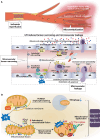The role and mechanisms of microvascular damage in the ischemic myocardium
- PMID: 37898977
- PMCID: PMC11073328
- DOI: 10.1007/s00018-023-04998-z
The role and mechanisms of microvascular damage in the ischemic myocardium
Abstract
Following myocardial ischemic injury, the most effective clinical intervention is timely restoration of blood perfusion to ischemic but viable myocardium to reduce irreversible myocardial necrosis, limit infarct size, and prevent cardiac insufficiency. However, reperfusion itself may exacerbate cell death and myocardial injury, a process commonly referred to as ischemia/reperfusion (I/R) injury, which primarily involves cardiomyocytes and cardiac microvascular endothelial cells (CMECs) and is characterized by myocardial stunning, microvascular damage (MVD), reperfusion arrhythmia, and lethal reperfusion injury. MVD caused by I/R has been a neglected problem compared to myocardial injury. Clinically, the incidence of microvascular angina and/or no-reflow due to ineffective coronary perfusion accounts for 5-50% in patients after acute revascularization. MVD limiting drug diffusion into injured myocardium, is strongly associated with the development of heart failure. CMECs account for > 60% of the cardiac cellular components, and their role in myocardial I/R injury cannot be ignored. There are many studies on microvascular obstruction, but few studies on microvascular leakage, which may be mainly due to the lack of corresponding detection methods. In this review, we summarize the clinical manifestations, related mechanisms of MVD during myocardial I/R, laboratory and clinical examination means, as well as the research progress on potential therapies for MVD in recent years. Better understanding the characteristics and risk factors of MVD in patients after hemodynamic reconstruction is of great significance for managing MVD, preventing heart failure and improving patient prognosis.
Keywords: Microvascular damage; Microvascular endothelial cells; Microvascular leakage; Microvascular obstruction.
© 2023. The Author(s), under exclusive licence to Springer Nature Switzerland AG.
Conflict of interest statement
There are no conflicts of interest to declare.
Figures





References
-
- Organization WH (2021) Cardiovascular diseases (CVDs). Retrieved from https://www.who.int/en/news-room/fact-sheets/detail/cardiovascular-disea...). Accessed 14 Feb 2023
Publication types
MeSH terms
Grants and funding
- U1903212/National Natural Science Foundation of China
- 81870272/National Natural Science Foundation of China
- 2021D04020/Natural Science Foundation of Xinjiang Province
- SKL-HIDCA-2021-XXG1/the State Key Laboratory of Pathogenesis, Prevention and Treatment of Central Asia High Incidence Diseases fund
- SKL-HIDCA-2022-XXG1/the State Key Laboratory of Pathogenesis, Prevention and Treatment of Central Asia High Incidence Diseases fund
LinkOut - more resources
Full Text Sources
Medical

